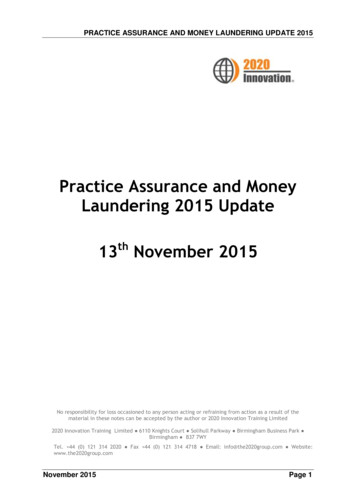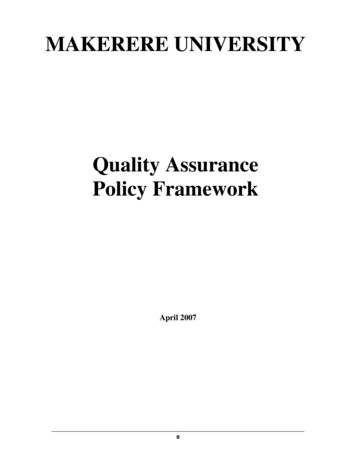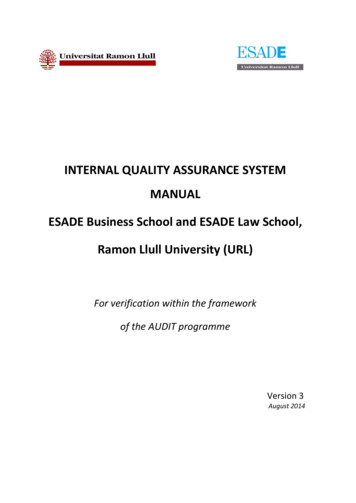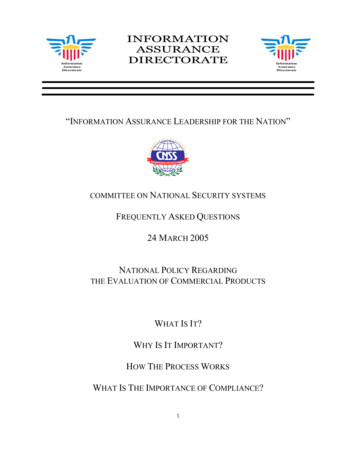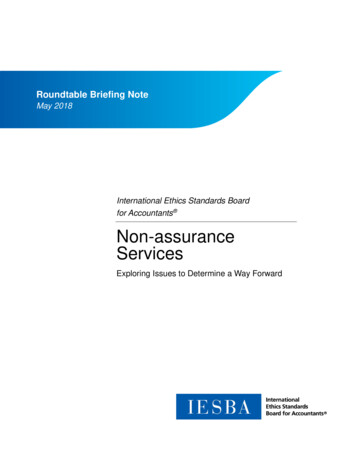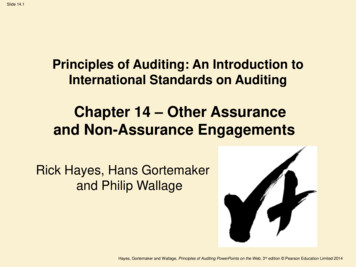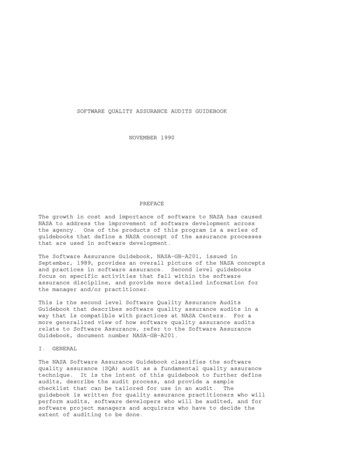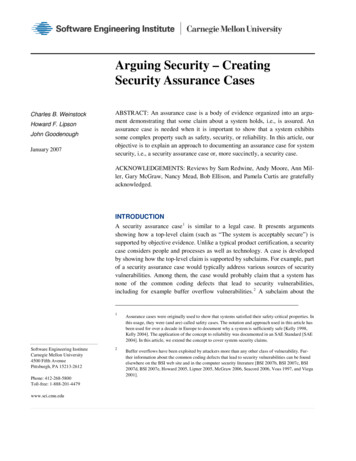
Transcription
Arguing Security – CreatingSecurity Assurance CasesCharles B. WeinstockHoward F. LipsonJohn GoodenoughJanuary 2007ABSTRACT: An assurance case is a body of evidence organized into an argument demonstrating that some claim about a system holds, i.e., is assured. Anassurance case is needed when it is important to show that a system exhibitssome complex property such as safety, security, or reliability. In this article, ourobjective is to explain an approach to documenting an assurance case for systemsecurity, i.e., a security assurance case or, more succinctly, a security case.ACKNOWLEDGEMENTS: Reviews by Sam Redwine, Andy Moore, Ann Miller, Gary McGraw, Nancy Mead, Bob Ellison, and Pamela Curtis are gratefullyacknowledged.INTRODUCTIONA security assurance case 1 is similar to a legal case. It presents argumentsshowing how a top-level claim (such as “The system is acceptably secure”) issupported by objective evidence. Unlike a typical product certification, a securitycase considers people and processes as well as technology. A case is developedby showing how the top-level claim is supported by subclaims. For example, partof a security assurance case would typically address various sources of securityvulnerabilities. Among them, the case would probably claim that a system hasnone of the common coding defects that lead to security vulnerabilities,including for example buffer overflow vulnerabilities. 2 A subclaim about the1Software Engineering InstituteCarnegie Mellon University4500 Fifth AvenuePittsburgh, PA 15213-2612Phone: 412-268-5800Toll-free: 1-888-201-4479www.sei.cmu.edu2Assurance cases were originally used to show that systems satisfied their safety-critical properties. Inthis usage, they were (and are) called safety cases. The notation and approach used in this article hasbeen used for over a decade in Europe to document why a system is sufficiently safe [Kelly 1998,Kelly 2004]. The application of the concept to reliability was documented in an SAE Standard [SAE2004]. In this article, we extend the concept to cover system security claims.Buffer overflows have been exploited by attackers more than any other class of vulnerability. Further information about the common coding defects that lead to security vulnerabilities can be foundelsewhere on the BSI web site and in the computer security literature [BSI 2007b, BSI 2007c, BSI2007d, BSI 2007e, Howard 2005, Lipner 2005, McGraw 2006, Seacord 2006, Voas 1997, and Viega2001].
absence of buffer overflow vulnerabilities could be supported by showing that(1) programmers were trained on how to write code that minimizes thepossibility of buffer overflow vulnerabilities; (2) experienced programmersreviewed the code to see if any buffer overflow possibilities existed and foundnone; (3) a static analysis tool scanned the code and found no problems; and (4)the system and its components were tested with invalid arguments and all suchinputs were rejected or properly handled as exceptions.In this example, the “evidence” would consist of programmer trainingcredentials, the results of the code review, the output of the code scanner, and theresults of the invalid-input tests. The “argument” is, “Following best codingpractice has value in preventing buffer overflow coding defects. Each of theother methods has value in detecting buffer overflow defects; none of themdetected such defects (or these defects were corrected 3), and so, the existingevidence supports the claim that there are no buffer overflow vulnerabilities.” 4Further information could show that this claim is incorrect. Our confidence inthe argument (i.e., in the soundness of the claim) depends on how convincing wefind the argument and the evidence. Moreover, if we believe that theconsequences of an invalid claim are sufficiently serious, we might require thatfurther evidence or other subclaims be developed. The seriousness of a claimwould depend on the potential severity of an attack (e.g., projected economicloss, injury, or death) related to that claim and on the significance of the threat ofsuch an attack. Although an in-depth discussion of the relation of threat andimpact to security cases is beyond the scope of this article, a comprehensivesecurity case should include, or at least be developed in the context of, analysesof the threats to a system and the projected impact of successful attacks.The structure for a partially developed security assurance case focusing on bufferoverflow coding defects is shown in Figure 1. The case is presented in agraphical notation called Goal Structuring Notation (GSN) [Kelly 2004].34The proper response to the detection of programmer errors is not simply to correct the code, but alsoto keep a record of the defects found and to use that information to improve the process that createdthe defect. For example, based on the nature of the defects detected, the training of programmers inbest coding practices may have to be improved. One might also search other products for similar defects and remind (or retrain) programmers regarding these defects.Of course, despite our best efforts, this claim might be invalid; the degree of confidence that we havein the argument supporting any given claim is an assertion about the case itself rather than an assertion about what is claimed, that is, when we say a system is “acceptably” secure or that it meets itssecurity requirements, we provide an argument and evidence in support of these claims. The extentto which the case is convincing (or valid) is determined when the case is reviewed.1 ARGUING SECURITY – CREATING SECURITY ASSURANCE CASES
The case starts with a claim (in the shape of a rectangle) that “The system isacceptably secure.” To the right, a box with two rounded sides, labeled“Acceptably Secure,” provides context for the claim. This element of the caseprovides additional information on what it means for the system to be“acceptably” secure. For example, the referenced document might cite HIPAArequirements as they apply to a particular system, or it might classify the kindsof security breaches that would lead to different levels of loss (laying the basisfor an expectation that more effort will be spent to prevent the more significantlosses).Under the top-level claim is a parallelogram labeled “SDLC.” This elementshows the strategy to be used in developing an argument supporting the top-levelclaim. Explicitly showing the strategy is optional but provides helpful insight toanyone reviewing the case. In this example, the strategy is to address potentialsecurity vulnerabilities arising at the different stages of the softwaredevelopment life cycle (SDLC), namely, requirements, design, implementation(coding), and operation. 5 One source of deficiencies is coding defects, which isthe topic of one of the four subclaims. The other subclaims cover requirements,design, and operational deficiencies. (The diamond under a claim indicates thatfurther development—i.e., further expansion—is required to fully elaborate theclaim-argument-evidence substructure.) The structure of the argument impliesthat if these four subclaims are satisfied, then the system is acceptably secure.The strategy for arguing that there are no coding defects involves addressingactions taken both to prevent and detect possible vulnerabilities caused bycoding defects. 6 In Figure 1, only one possible coding defect, buffer overflow, isdeveloped. Three types of evidence are developed to increase our confidence thatno buffer overflow vulnerabilities are present. These types of evidence areassociated with each of three subclaims. The “Code Scanned” subclaim assertsthat static analysis of the code has demonstrated the absence of buffer overflowdefects. Below that are the subclaims that the tool definitively reported “NoDefects” and also that all warnings reported by the tool were all subsequently56We omit validation or testing (as a development activity) because these will be included within thesecurity case itself.The strategy might also consider actions taken to mitigate possible vulnerabilities caused by codingdefects, although we don’t illustrate this in our example. Such actions could include the use of toolsand techniques that provide runtime protection against buffer overflow exploits [Plakosh 2006] inthe event that some buffer overflow vulnerability was neither prevented nor detected prior to releaseof the code. Although not illustrated in our example, the strategy might also include a formal methods approach [Chaki 2006].2 ARGUING SECURITY – CREATING SECURITY ASSURANCE CASES
verified as false alarms (i.e., “Warnings OK”). Below these subclaims are twopieces of evidence. The first is the tool output, which is the result of running thestatic analysis tool. The second is the resolution of each warning message,showing why each was a false alarm.This is not a complete exposition of GSN. For instance, two other symbols, notshown in Figure 1, include “justification” and “assumption.” As with the contextelement, these are used to provide additional information helpful inunderstanding the claim.3 ARGUING SECURITY – CREATING SECURITY ASSURANCE CASES
Figure 1. Partially expanded security assurance case that focuses on bufferoverflowThe claims in the example are primarily product-focused and technical (i.e., theclaims address software engineering issues). An assurance case may also requiretaking into account legal, regulatory, economic (e.g., insurance), and other nontechnical issues [Lipson 2002]. For example, a more complete case mightcontain claims reflecting the importance of legal or regulatory requirementsrelating to Sarbanes-Oxley or HIPAA. In addition, an analysis of the threat andconsequences of security breaches will affect how much effort is put intodeveloping certain claims or types of argument. If a security breach can lead to a4 ARGUING SECURITY – CREATING SECURITY ASSURANCE CASES
major regulatory fine, the case may require a higher standard of evidence andargumentation than if a breach has little economic penalty.Developing a security assurance case is not a trivial matter. In any real systemthe number of claims involved and the amount of evidence required will besignificant. The effort involved is offset by an expected decrease in effortrequired to find and fix security-related problems at the back end of productdevelopment and by a reduced level of security breaches with their attendantcosts. Although we believe that the return on investment (ROI) for developingsecurity cases would typically be substantial, work is needed in the communityto gather the hard evidence necessary to support this assumption. 7Creating and evolving the security case as the system is being developed ishighly recommended. Developing even the preliminary outlines of an assurancecase as early as possible in the software development life cycle (SDLC) can leadto improvement in the development process by focusing attention on what needsto be assured and what evidence needs to be developed at each subsequent stageof the SDLC. Attempting to gather or generate the necessary security caseevidence once development is complete may not only be much more costly, itmay be impossible.In the next section, we present a method for diagramming the overall structure ofa security assurance case so it is easier to review for completeness andsoundness. We are not so much interested in discussing specific techniques forgathering evidence or making arguments as we are in showing how to documentthe case so it can be reviewed and evaluated for sound reasoning and in light ofthe evidence. In a later section, we present the concept of a “security casepattern,” which takes advantage of the fact that certain arguments occur againand again when evaluating security claims. We will discuss how to create anduse such patterns.How to Create a Security Assurance CaseCreating and presenting security assurance cases in a form that facilitates outsidereview requires some care. While the case can be presented textually, reviewersoften find a graphical representation much easier to understand, and we expectthat developers and maintainers will find it more useful as well.7See the BSI website content areas on Business Case and Measurement for material relevant to making ROI arguments [BSI 2007a, BSI 2007f].5 ARGUING SECURITY – CREATING SECURITY ASSURANCE CASES
Argument StructureA security assurance case consists of a structured collection of security-relatedclaims, arguments, and evidence. A claim embodies what is to be shown; anargument tells why to believe a claim has been met, based upon subclaims andevidence such as results of tests, simulations, analysis, etc. Reviewers must beable to understand a security case, so how the evidence supports a claim needs tobe clear. Having just a single top-level claim (e.g., “The system does what it’ssupposed to do”) and supporting evidence, without knowing specifically how theevidence relates to the claims, is not appropriate. Instead of requiring a giant leapfrom top-level claim to evidence, a security assurance case breaks claims intosubclaims, each of which is broken into yet another level of subclaims (as inFigure 1) until the step to the actual evidence that supports that subclaim isreasonably small. This structure is shown in Figure 2.Figure 2. The “claim-argument-evidence” structure of an assurance caseCreating a Structured ArgumentClaimsCreating a structured argument is a relatively straightforward process, bestaccomplished in a top-down manner. The process starts by identifying top-level6 ARGUING SECURITY – CREATING SECURITY ASSURANCE CASES
claims to be made. These top-level claims should provide the “take-home”message for the reviewers and should convince them (if supported) that therequired attributes have been satisfied. In general, claims should bestraightforward statements that do not consider implementation details. “SystemX is acceptably secure” might be a good top-level claim while “System X isacceptably secure through the use of a virtual private network” is not. Theimplementation details should be part of the support of the claim, not part of theclaim itself. That said, it is also important that the top-level claim not be oversimplified. “System X is secure” is not as useful a top-level claim as “System Xis acceptably secure.” The latter claim allows for a richer and more realisticargument structure involving cost/benefit analyses and risk-managementtradeoffs. Getting the top-level claim right is important. It is the seed from whichthe arguments can develop, and if it doesn’t contain the right concepts orincludes too-specific details its usefulness may be limited.The following are examples of claims that are properly worded: The tool detected no defects.The system is acceptably secure.The following are examples of claims that are poorly worded: Hazard Log for System Y (describes an entity)Run static analysis tool Z (an action, not a statement).A claim is properly worded if it is a predicate, i.e., a statement that is either trueor false.Establishing ContextThe text that states each claim must be succinct and unambiguous if theargument is to be reviewable. Yet it is often necessary to provide additionalinformation that is not directly part of the argument. For instance the claim maycontain terms that are not generally known, or it may refer to a standard or arequirements document, etc. Context is used to provide this additionalinformation. For example: “Context: Acceptably secure for this system isdefined in requirements document R.” The context is not a part of the actualargument. Justification and assumption cues are used similarly: to provideadditional information to make the argument more understandable.Identifying StrategyAs defined above, the strategy is an additional cue that helps the readerunderstand the form that an argument is going to take. Instead of being true orfalse statements, as the claims and subclaims are, the strategy provides7 ARGUING SECURITY – CREATING SECURITY ASSURANCE CASES
information on how to substantiate the stated claim. The strategy can take manyforms, but it is often simply a matter of presentation. The example in Figure 1shows strategies (i.e., the “SDLC” and “Prevention and Detection”parallelograms) that describe how a claim is to be supported, typically bysubclaims that cover all relevant possibilities, each of which is likely to be easierto deal with than the overall claim.The strategy can be explicit (as in Figure 1) or implicit (as it would be if wehadn’t added any strategies to that figure). Sometimes the strategy is obviousfrom the layout of the subclaims, in which case an implicit strategy is fine.However, if the relationship between a claim and a set of subclaims has anycomplexity, or if the strategy being used requires additional context, it should beexplicit.Strategies should not contain claims. They should be phrased with respect to theargument, not with respect to the design, testing, or analysis approach. Thus itwould be wrong to say “Use Byzantine Agreement protocol.” Rather the strategyshould be “Argument by appeal to the Byzantine Agreement protocol.”Technically, removing a strategy cue does not affect the argument being made,but can affect ease and correctness of understanding. As with claims, it issometimes helpful to link context, justification, or assumptions to the strategy.Elaborating the StrategyA strategy is elaborated by providing a series of subclaims that fulfill theselected approach. For example, for a strategy ranging over all subsystems,claims must be made that cover each individual subsystem. For a strategyinvolving quantitative results there must be quantitative claims. Elaboratingthese claims is exactly the same as elaborating the top-level claim. If a goodstrategy has been chosen and the basis for the strategy is clear, this can be verystraightforward.EvidenceEventually, as the expansion continues, there will come a point where a claimneeds no further refinement and can be directly supported by evidence. Forinstance, see the “evidence circles” at the bottom of Figure 1, which support thesubclaims directly above them. The evidence elements show the results ofrunning a static analysis tool, the results of reviewing any warnings produced bythe tool, and the results of testing the code with invalid input.One caveat: what may seem obvious (and therefore not requiring refinement) tothe creator of an assurance case may not be at all obvious to the typical reader ofthe case. When in doubt, it is best to err on the side of providing too many stepsbetween a claim and its supporting evidence rather than too few.8 ARGUING SECURITY – CREATING SECURITY ASSURANCE CASES
Any type of evidence can support security assurance arguments, but clearly sometypes of evidence are better than others. The BSI article, “Evidence ofAssurance: Laying the Foundation for a Credible Security Case,” [Lipson 2008]presents examples of the kinds of evidence that may be well suited for use insecurity cases. Details on the kinds of evidence that could support assurancearguments about security properties are also given throughout the SoftwareAssurance Common Body of Knowledge (SwA CBK) [Redwine 2007] (inparticular, see Table 5, "Kinds of Evidence"). 8It is important to realize that the terse descriptions that appear inside the“evidence circles” in our security assurance case example are simply referencesto the actual evidence. The GSN tool provides a capability for adding hyperlinksso that a security assurance case can serve as an index to a collection ofdocuments representing relevant evidence. More sophisticated tools could allowthe case to serve as, or to be an integral part of, an evidence repository.Tools and NotationAlthough this document has shown the development of a security assurance caseusing the Goal Structuring Notation, other notations are available (e.g., AdelardSafety Case Development – ASCAD [Adelard 2003]). As long as the structure ofthe argument is clearly presented, the method of exposition of the case and thetools used to develop the case are at the discretion of the case’s creator. 9Although an assurance case presented in GSN can be created using any generalpurpose graphics editor, direct tool support for GSN is available to ease theprocess. An example of a commercially-available tool that supports GSN (alongwith some other relevant notations) is Adelard’s Assurance and Safety CaseEnvironment.The Security Assurance Case Throughout the Life CycleFor maximum utility, a security assurance case is a document that changes as thesystem it documents changes. The case takes on a different character as a projectmoves through its life cycle. In the pre-development stage the case focuses onshowing that89There are also discussions of relevant concepts, principles, and practices (and extensive references tothe software assurance literature).One of the earliest prototype tools for creating and documenting security assurance arguments wasthe Visual Network Rating Methodology, developed at the Naval Research Laboratory [Park 2001].9 ARGUING SECURITY – CREATING SECURITY ASSURANCE CASES
the plan for a security case is appropriate for the security requirements of theproposed system,the technical proposals are appropriate for achieving the securityrequirements of the proposed system, andit will be possible to demonstrate that security has been achieved during theproject.At development time the security assurance case (which is derived from the predevelopment case) is updated with the results of all activities that contribute to the securityevaluation (including evidence and argumentation) so that, by the time ofdeployment, the case will be complete, andpresented at design (and other) reviews and the outcomes included in thecase.Using a configuration control mechanism to manage the security case will ensureits integrity as well as help the case always be relevant to the development status.Security cases provide a structured framework for evaluating the impact ofchanges to the system and can help ensure that the changes do not adverselyimpact security. The case should continue to be maintained after deployment ofthe system, especially whenever the system is modified. Examining the currentcase can help determine if modifications will invalidate or change arguments andclaims and, if so, will help identify the appropriate parts of the case that need tobe updated. Further, if parts of the system prove insecure even in the face of awell-developed case, it is important to understand why this particular chain ofevidence-argument-claim reasoning was insufficient.How to Create Security Case PatternsThe Need for PatternsThe process of developing an assurance case is simplified, somewhat, throughthe introduction of assurance case patterns. Patterns maintain the structure, butnot the specific details, of an argument and therefore can be instantiated inmultiple situations as appropriate. By building a catalog of patterns (i.e.,templates), one can facilitate the process of assurance case creation anddocumentation. Assurance case patterns offer the benefits of reuse andrepeatability of process, as well as providing some notion of coverage orcompleteness of the evidence.Our specific focus is on how to develop and use such patterns for security cases.The salient characteristic of a security case is that it is a structured artifact that is10 ARGUING SECURITY – CREATING SECURITY ASSURANCE CASES
reviewable by a broad range of stakeholders, not limited to security experts.Security case patterns offer the promise of extending the engineering benefits ofa repeatable process to the development of security cases for a wide range ofsoftware development projects. Reuse of a common argument structure eases thecreation of security cases since each case no longer has to be custom-built. Apattern that has been “battle-tested” through repeated use (especially if sharedamong multiple organizations) is more likely to be complete in its coverage thana new security case developed from scratch, and so, important variations ofevidentiary and argument chains are less likely to be overlooked. A repeatableprocess is more amenable to oversight, training of personnel, detection ofdefects, and continuous improvement. Moreover, the return on investment of arepeatable process may be easier to determine.To fully support reusability, a security case pattern should clearly outline thesecurity claim, the profile of the argument to be made, the types of evidence thatsupport that argument, and possibly some measures or weighting of the value ofparticular (types of) evidence. The context or conditions under which theparticular pattern applies should also be fully specified, as well as how thepattern is instantiated, pitfalls in applying the pattern, and when the patternshould not be used. We would expect to see such well-crafted security casepatterns become more commonplace as the community gains experience increating and evaluating security case patterns and their instantiations. Moreover,security case patterns can serve to embody “best practices” for developing securesystems. For example, the application of static code analysis tools is a bestpractice that is recommended elsewhere in the BSI website (see Code Analysisand Source Code Analysis). In Figure 1, we included this practice in ourexample security case. A case that includes a larger number of such bestpractices would presumably be considered more convincing by knowledgeablereviewers.Turning Our Previous Example Into a PatternA very simple and straightforward way to create a security case pattern is to startwith a given security case and then parameterize one or more of the contentelements. For example, we can turn Figure 1 into a pattern by documentingwhere choices can be made. The resulting security case pattern is shown inFigure 3, where we have added two black diamond symbols to identify choices.The “at least 1” connector allows a choice among the argument structures for“Code Review,” “Code Scanned,” and “Robustness Testing.” The patternindicates that the “Coding Defect” claim can be supported either by code review,static analysis, or robustness testing and that at least one of these alternativesshould be selected for each type of coding defect. When the consequences of atype of coding defect are potentially more severe, the developer of the assurance11 ARGUING SECURITY – CREATING SECURITY ASSURANCE CASES
case might want to improve the credibility of the case by selecting two of thethree alternatives, or even all three, as we did in Figure 1. On the other hand,certain types of coding defects may not be detectable by an existing staticanalysis tool, in which case this alternative would be eliminated from the case.When applying a pattern and eliminating an alternative, it is a good idea to insertsome justification explaining the absence of that alternative in the context ofyour particular circumstances in order to show that you have not simplyoverlooked a common argument structure or type of evidence that couldcontribute to your case.The second use of the black diamond is associated with the claim “CodeScanned.” This diamond says that one of the two possibilities must be chosen,since they are mutually exclusive: either the tool produces no warnings, in whichcase nothing further is to be done, or the tool produces warnings, and furtheranalysis is needed to show that the warnings are benign.The shaded elements of Figure 3 have been further parameterized with text inbraces indicating how a particular claim or piece of evidence is to beinstantiated. The parameter “Coding Defect Type X” replaces the specific defect“Buffer Overflow” that appeared in several places in Figure 1.Using PatternsSecurity case patterns are claims-argument-evidence structures that can bereused in many different security cases. The security case method offers theopportunity for security and domain experts to codify security knowledge andmitigation strategies in the form of security case patterns. Such patterns can thenbe shared among the security community and other stakeholder communities andcontinually built upon, refined, and improved. We envision a growing repositoryof security case patterns for a variety of domains and operational contexts thatnot only would provide greater opportunities for reuse and standardization ofassurance arguments, but also (with appropriate information sharing) could allowthe security community to associate an historical record of security performance(and return on investment) with particular security case patterns. The historicalrecord of systems built with particular security case patterns can itself contributeto the evidence necessary to make a compelling argument that a system satisfiesits desired security properties! However, to safely enable widespread sharing ofsecurity case patterns, the importance of understanding and clearly specifying theenvironmental and operational context within which a security case pattern isvalid cannot be overemphasized.Finally, security case patterns that are proven effective and widely shared canencourage worthwhile improvements in organizations’ development processes sothat the artifacts needed by the security case patterns are created by the12 ARGUING SECURITY – CREATING SECURITY ASSURANCE CASES
development processes at the appropriate stages of the software development lifecycle.Figure 3. A security case patternRelated Security Assurance and Compliance EffortsThis section briefly describes how some existing assurance and complianceefforts relate to security cases and patterns.Security-Privacy Laws and RegulationsLaws and regulations such as Sarbanes-Oxley and HIPAA mandate specificsecurity and privacy requirements. Security assurance cases can be used to argue13 ARGUING SECURITY – CREATING SECURITY ASSURANCE CASES
that a cor
elsewhere on the BSI web site and in the computer security literature [BSI 2007b, BSI 2007c, BSI 2007d, BSI 2007e, Howard 2005, Lipner 2005, McGraw 2006, Seacord 2006, Voas 1997, and Viega . the defect. For example, based on the nature of the defects detected, the training of programmers in best coding practices may have to be improved. One .
